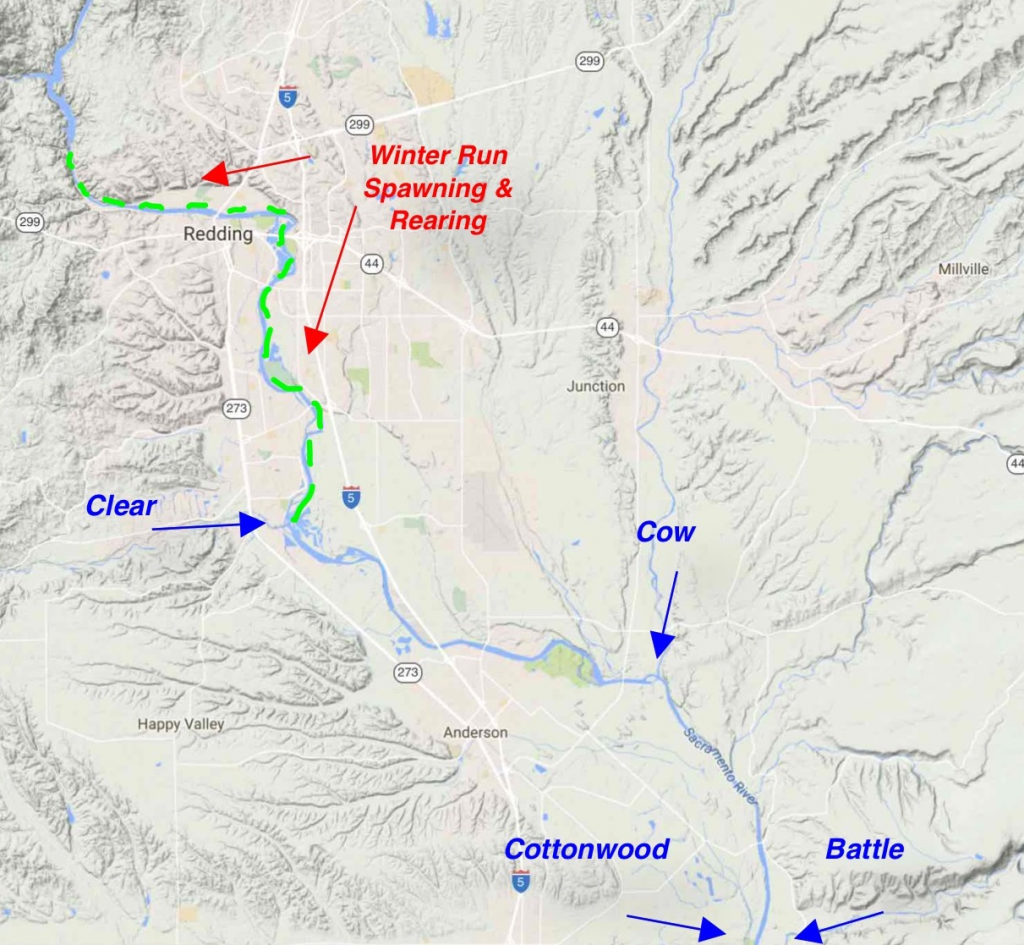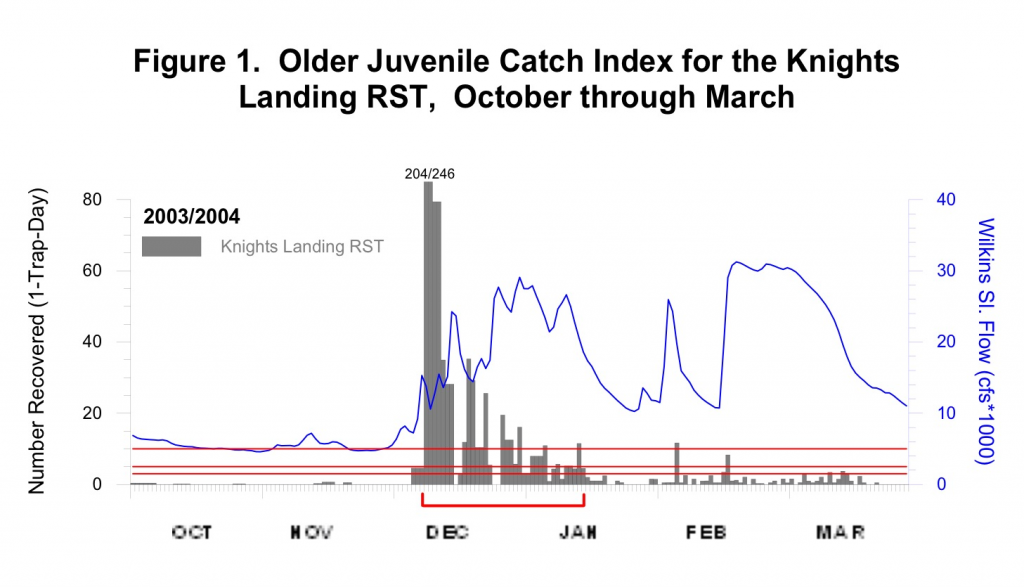In a recent post I suggested “spill” (targeted reservoir releases) to enhance salmon production in Central Valley rivers. Well, it is now time to employ spill to help Winter Run and Spring Run Chinook salmon in the upper Sacramento River below Shasta near Redding. Waiting for El Niño to help these fish may be too late. Confidence and early indications that El Niño will come this winter should make the necessary commitment for spill now more palatable. Spill releases could have already been made from Shasta Reservoir with these recent storms to support emigration of young salmon from the spawning and rearing reach.
After the salmon spawning, irrigation, and water transfer season ended in October, there have only been minimum flows and no spills to enhance young salmon emigration. Flow from Shasta-Keswick (river mile 302) has remained near the minimum requirement of 4000 cfs (Figure 1).
Recent Storms – December 2015
The recent storms have sharply increased flow in the Sacramento River downstream of the spawning reach at Bend Bridge at river mile 258 (Figure 2) below the input of four large creeks entering the Sacramento River below Redding (Figure 3). Inflow to Shasta Reservoir has nearly quadrupled during the two storms, reaching 8,000-10,000 cfs. A prescriptive “spill” release of 5-10% of inflow (500-1000 cfs) is needed. That would raise Keswick releases to about 5000 cfs, which would help stimulate emigration from the spawning reach into the higher flow reach below the tributaries, and down into and through the Delta.
December 2003 Case Study and Precedent
December 2003 had similar circumstances. Screw trap catch of Winter Run salmon at Knights Landing (RM 90) had a sharp increase coincident with flow increases in December 2003 (Figure 4). Spill in December 2003 (Figure 5) helped increase the river flow.
Concern for Young Salmon in the Delta
Higher freshwater inflows from the storms in 2015 have already pushed the Low Salinity Zone out of the Delta into Suisun Bay. Winter Run and Spring Run salmon (as well as Late Fall smolts and Fall Run fry) are likely now entering the Delta in large numbers (comparable monitoring results from 2003-4 are shown in Figure 6). Spill wouldl help move fish through the Delta and west to the Bay. The Delta Cross Channel remains open, allowing the emigrating salmon to spread into the Central Delta. This increases the need for spill to keep these fish moving west before the DCC is closed and south Delta exports divert freshwater inflow and emigrating salmon away from the Bay and toward the Delta pumps.
Spill is also needed from other reservoirs on the Feather, Yuba, and American Rivers that have also received significant inflow during the recent storms. Spill from these reservoirs is needed to stimulate migration of young salmon from their tailwaters as well as to contribute more to the combined Delta inflow and outflow.
Though it is a hard decision not to store all of the inflow from these first storms of the season in reservoirs, releasing 5-10% as spill would go a long way to help saving the wild endangered salmon that depend on the early winter flows.

Figure 1. Flow releases to Sacramento River from Keswick Reservoir fall 2015. Minimum prescribed outflow to Sacramento River is approximately 4000 cfs in drought years like 2015. Keswick Dam is at rivermile 302, nine miles below Shasta Dam.

Figure 2. Flow in the Sacramento River at Bend Bridge (RM 258) 44 miles below Keswick Dam fall 2015. Flow spikes from recent storms come from local tributary creeks upstream of Bend Bridge.

Figure 3. Location of Winter Run spawning and rearing reach (green hatched line) below Keswick Dam (RM 302) near Redding, CA. Four major tributary creek inputs are shown below Redding. The mouths of Cottonwood and Battle Creeks are about RM 270.

Figure 4. Catch index of older juvenile (non-fry) in Knights Landing (RM 90) rotary screw trap Oct 2003-Mar 2004. Source: http://www.science.calwater.ca.gov/pdf/ewa /support_docs_110804/Salmon%20Criteria%20Figures%201_2_Chappell.pdf

Figure 5. Flow releases to Sacramento River from Keswick Reservoir fall 2003. Releases were approximately doubled to 9000 cfs at mid-month, ostensibly to help stimulate young salmon emigration and allow greater Delta exports 1.

Figure 6. Catch index of older juvenile (non-fry) in trawls and seines in the Sacramento River near Sacramento, Oct 2003-Mar 2004. Source: http://www.science.calwater.ca.gov/pdf/ewa /support_docs_110804/Salmon%20Criteria%20Figures%201_2_Chappell.pdf
- High exports in December03-January04 did result in substantial counts of juvenile Winter Run salmon at South Delta Fish Salvage Facilities during the period. ↩
